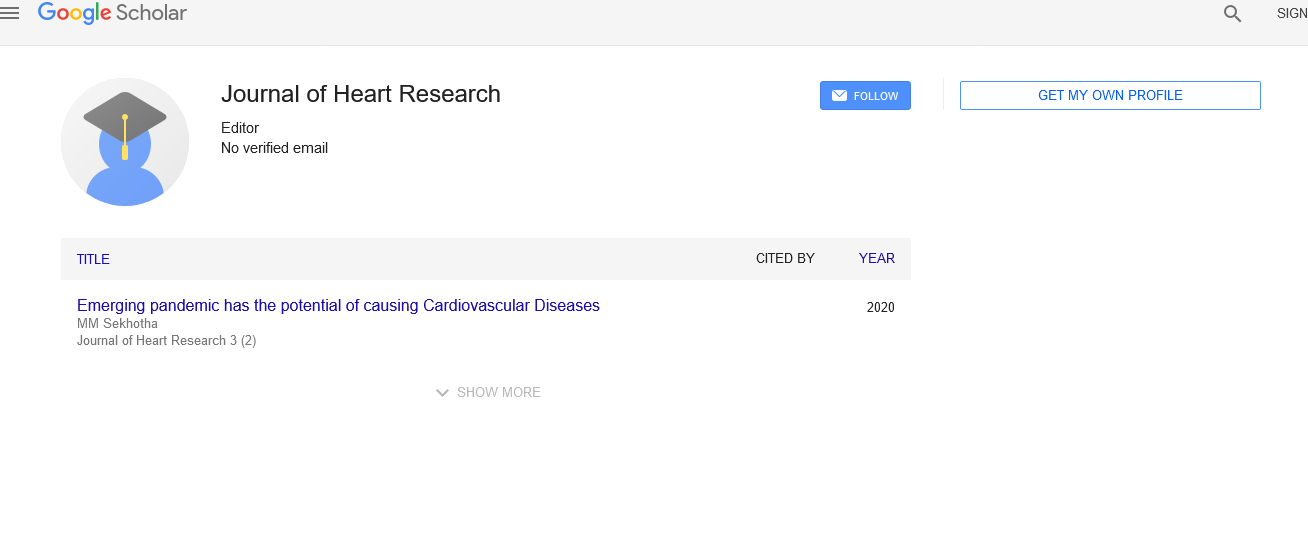Coronary CT angiography for quantitative assessment of coronary plaques
Received: 09-Jun-2022, Manuscript No. puljhr-22-5043; Editor assigned: 13-Jun-2022, Pre QC No. puljhr-22-5043 (PQ); Accepted Date: Jun 28, 2022; Reviewed: 22-Jun-2022 QC No. puljhr-22-5043 (Q); Revised: 25-Jun-2022, Manuscript No. puljhr-22-5043 (R); Published: 30-Jun-2022, DOI: 10.37532/puljhr.22.5(3).28-29
Citation: Iglesias M. Coronary CT angiography for quantitative assessment of coronary plaques. J Heart Res. 2022; 5(3):28-29.
This open-access article is distributed under the terms of the Creative Commons Attribution Non-Commercial License (CC BY-NC) (http://creativecommons.org/licenses/by-nc/4.0/), which permits reuse, distribution and reproduction of the article, provided that the original work is properly cited and the reuse is restricted to noncommercial purposes. For commercial reuse, contact reprints@pulsus.com
Abstract
The quantitative assessment of coronary plaques using Coronary Computed Tomography (CT) angiography is the main point of the article. It discusses three major findings: First, with the use of state-of-the-art CT scanners, coronary CT angiography is an accurate imaging technique for analyzing plaque volume and tracking volume change, with the great inter-and intra-reader agreement. Second, when plaque volume assessment is performed by the same vendor, scan variability is modest, but when assessment is performed by separate vendors at baseline and follow-up scans, scan variability is over 30%. Finally, assessing non-calcified plaques necessitates a high sample size, especially when using diverse vendors.
Keywords
coronary artery disease; coronary ct angiography; coronary plaque; variability
Introduction
Coronary CT Angiography (CCTA) is a commonly utilized imaging modality for diagnosing patients with suspected Coronary Artery Disease (CAD) that has been shown to have excellent diagnostic accuracy in the literature. Over the last decade, rapid technological advancements in cardiac CT imaging have led to the creation and improvement of the diagnostic spectrum of CCTA in the quantitative analysis of coronary plaques, as well as the diagnostic value of coronary artery stenosis. In addition to the standard assessment of coronary lumen stenosis, these included characterization of plaque characteristics and the corresponding clinical consequences such as prediction of significant adverse cardiac events. Plaque component detection, particularly discrimination of non-calcified (vulnerable) from calcified (stable) plaques, is more important than lumen stenosis detection because there is a strong link between plaque composition and myocardial ischemia and the development of unfavorable cardiac events. Because the degree of lumen stenosis is not always associated with myocardial ischemia alterations, the current research direction of CCTA has mostly focused on the quantitative assessment of plaque features rather than coronary lumen analysis.
Intravascular Ultrasound (IVUS) and Optical Coherence Tomography (OCT) are two imaging modalities that allow for excellent plaque characterization by providing intravascular images of plaque components, but both are invasive and so are not often used in clinical practice. CCTA can give a quantitative assessment of plaque form and components, which adds incremental prognostic value to the diagnosis of CAD as a less invasive technique with extensive use in everyday practice. In the quantitative plaque analysis, there is accumulating evidence that CCTA has a high connection with IVUS. However, little study has been done on the agreement or variability of CCTA in the quantitative assessment of coronary plaques between readers and scanners. Based on the latest multislice CT scanners, the study looked into the variability of CCTA for assessing plaque volume. A total of 40 asymptomatic patients over the age of 55 who had a history of hyperlipidemia and were receiving medical treatment were included in the study. At baseline, a 320-slice CT Toshiba Aquiline One scanner was used to score coronary artery calcium (CAC) and perform CCTA. Within 30 days following the baseline scan, 20 patients underwent repeat CAC scoring and CCTA using two distinct CT scanners, with 20 patients using the same Aquiline One scanner and the other 20 using the Somatom Force 2x 192-slice dual-source scanner. At baseline and follow-up scans, two readers assessed and analyzed total plaque volume on a segment level as well as specific coronary lesion volume. Between the two groups undergoing separate scans, there was no significant difference in patient demographics. The assessment of total, non-calcified, and calcified plaques by CCTA for Toshiba and Siemens scanners revealed high inter-reader and intrareader agreement. When the follow-up CCTA was performed on a different type of CT scanner, scan-rescan variance was discovered. When the baseline and follow-up CT scans were done with the same Toshiba CT, the variability of CCTA was 18.4 percent and 16 percent for the measurement of noncalcified plaque volume for all coronary arteries and the most important lesion, respectively. When the baseline scan was performed on Toshiba CT and the follow-up examination was performed on Siemens CT, the corresponding CCTA variability was 29.9% and 26.4%, respectively, demonstrating considerable variability when follow-up CCTA was performed on a different type of scanner. CAC scoring had a low scan-rescan variance, with ICC >0.99 for both groups. Sample sizes for non-calcified plaque volume were computed by CCTA due to scan rescan variability in coronary plaque volume assessment. When a different vendor was employed to track plaque volume change, the estimated patients for lesion-based and vesselbased non-calcified plaque analyses were 587 and 753, respectively.
Three points from Symons' research are worth discussing. First, the accuracy and reliability of CCTA in the quantitative measurement of plaque volume are established. This finding is in line with recent research, which suggests that CCTA is becoming more widely used for coronary plaque imaging analysis. Low-attenuation area or noncalcified plaque is one of the most reliable indicators for determining plaque vulnerability and predicting severe adverse cardiac events among the many plaque features. A lot of investigations have corroborated this, with good concordance between CCTA and IVUS in plaque composition distinction. When comparing patients with acute coronary syndrome or the development of major adverse cardiac events to those with non-calcified or low-attenuating plaques, the main findings of these studies concluded that non-calcified or low-attenuating plaques were more frequently seen in patients with acute coronary syndrome or the development of major adverse cardiac events. As a result, measuring non-calcified plaque in terms of total plaque volume has clinical significance. The strong inter- and intra-reader agreement demonstrated in Symons' study has further validated CCTA's diagnostic utility in this area.
The second point to mention is the multislice CT scanner's inconsistency when it comes to measuring plaque volume. Toshiba 320- and Siemens Force scanners were the CT scanners used in this study. Although the temporal resolution (137.5 ms) is not as good as that of dual-source CT scanners, the 320-slice scanner allows for longitudinal coverage of 16 cm. A number of studies have shown that 320-slice CCTA has a high diagnostic value in coronary artery disease; while Siemens Force is a 3rd generation dual-source CT with enhanced z-axis coverage and improved temporal resolution that wasrecently put into clinical use (125 ms). When compared to earlier generations of dual-source CT scanners, recent research have indicated that 3rd generation dual-source CT scanners have greater diagnostic performance and lower radiation exposure. These two types of CT scans represent the most recent advances in cardiac CT imaging technology, and they will continue to be employed in clinical practice.The final point I'd want to make is on the sample size calculation. When various vendors are involved in follow-up exams, the authors calculated the sample amount required to detect 5% plaque volume changes by CCTA based on lesion-based and vesselbased analysis of non-calcified plaque. The sample size is generally acknowledged to play a crucial impact in study design and research conclusions. The majority of existing research is constrained by a small sample size or single-center experience, as stated in the study limitations. The sample size estimation given by Symons and colleagues can help other researchers create similar studies and derive more reliable findings.
In conclusion, this is an intriguing study that adds to the growing body of evidence that CCTA has a high diagnostic accuracy in the quantitative assessment of plaque volume, with excellent inter- and intra-reader agreement. To avoid scan-rescan variability, this study recommended that follow-up CCTA be conducted with the same vendor for diagnostic assessment of non-calcified plaque volume. When multiple vendors are involved at different periods of CT scans, a large sample size is necessary to detect plaque volume changes by CCTA. Despite the positive results given in this study, more research is needed to confirm the findings, particularly a longitudinal study with long-term treatment outcomes follow-up.





